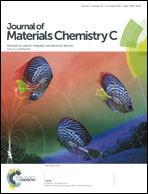Spectral shifting and NIR down-conversion in Bi3+/Yb3+ co-doped Zn2GeO4
Abstract
We report on spectral modification through NIR down-conversion (DC) photoluminescence (PL) in Yb3+-Bi3+-co-doped Zn2GeO4. Energetic downshifting (DS) of UV-A irradiation occurs via intrinsic luminescence of the high-bandgap semiconductor Zn2GeO4 as well as via active Bi3+ centres. In parallel, both species act as sensitizers for Yb3+, strongly extending its excitation region to ∼500 nm. In the absence of Bi3+, band-to-band absorption of Zn2GeO4 in the UV region results in PL at ∼475–625 nm. Doping with Yb3+ initiates energy transfer from trapped defect states to two neighbouring Yb3+ ions in a cooperative DC process, resulting in Yb3+-related photoemission at ∼1000 nm. The introduction of Bi3+ into Zn2GeO4:Yb3+ greatly extends the absorption band to the visible blue region. Then, energy transfer also occurs through cooperative DC from Bi3+ to Yb3+. As a result, a strong increase in the absolute Yb3+-related PL intensity is observed. This enables ultra-efficient harvesting of UV-A to visible radiation for energy conversion processes.


 Please wait while we load your content...
Please wait while we load your content...